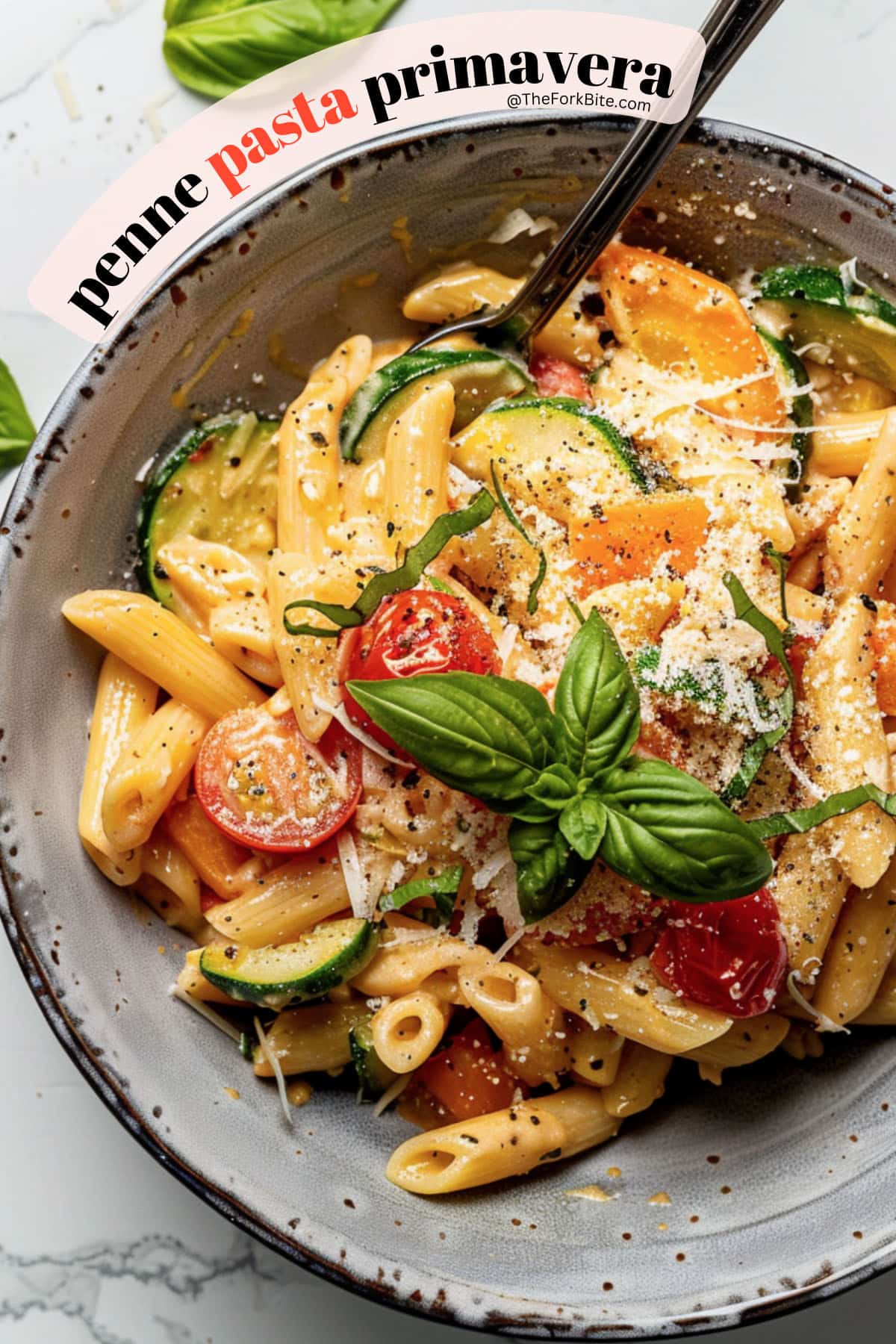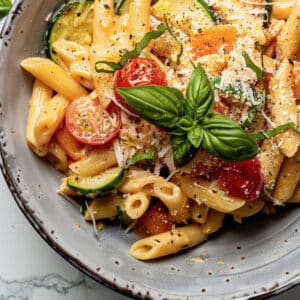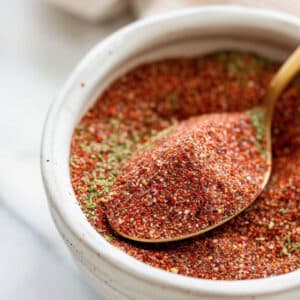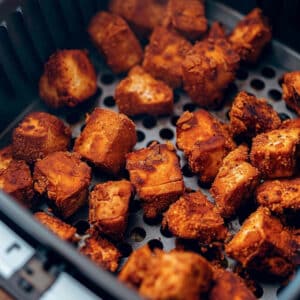Pasta Primavera – it's the dish that screams "fresh!" with vibrant colors and flavors that burst in your mouth. Think of it as a celebration of seasonal veggies tossed with perfectly cooked pasta, all coated in a light, flavorful sauce.
The best part? Pasta Primavera is incredibly customizable. Whether you're craving a classic combo, a vegetarian twist, or just want to use up those veggies in your fridge, this dish has endless possibilities.

Ingredients You'll Need
Ready to get cooking? The full ingredient list and measurements are in the recipe card below.
- Pasta (Penne): This is our foundation! Penne's shape is great for catching all the veggies and sauce. But hey, if you're feeling adventurous, farfalle (those cute bowties) or rotini (corkscrews) work just as well. Just make sure it cooks up "al dente" – a little firm to the bite, that's the key.
- The Veggie Squad (Carrots, Zucchini, Squash, Bell Peppers, Asparagus): This is where the color and flavor party happens! These are my go-tos, but you can switch it up based on what's freshest at the market or whatever's hanging out in your fridge. The important thing is to cut them into bite-sized pieces so they cook quickly and evenly.
- Onions: Yellow or white, it's up to you! Just make sure they feel heavy for their size and that the skin's all dry and papery. Good onions mean good flavor! Stash them somewhere cool and airy, and they'll be good for a while. But once you cut into one, wrap it up tight and keep it in the fridge – leftovers don't last forever, sadly.
- Cherry Tomatoes: These little guys add pops of color and sweetness. I like to slice them in half so they release a bit more juice. No roasting is needed! I just toss them into the pasta at the very end, so they stay bright and flavorful.
- Garlic Herb Butter Ingredients (Butter, Lemon Zest, Garlic, Basil, Parsley): Okay, this is where the magic happens. It's optional, but trust me, it makes everything sing. We're talking a little zippiness from the lemon zest, those garlicky herby vibes, and a touch of richness from the butter. Plus, it's easy to whip up while the pasta cooks! Check my Cheesecake Factory Butter recipe here.
- Parmesan Cheese: This is the salty, slightly nutty finishing touch that brings all the flavors together. Grated or finely shredded works best – it'll melt and coat everything beautifully.
- Olive Oil: The good stuff! A few tablespoons help saute those veggies to perfection and create the base for our light sauce.
- Herbes de Provence: This is my little secret weapon. It's a blend of savory herbs like thyme, rosemary, and oregano that gives the dish a lovely depth of flavor. You can buy it thru Amazon.
- Salt and Pepper: The OGs of seasoning! Don't underestimate their power to wake up all those delicious flavors.
Remember: This is just a starting point – Pasta Primavera is totally about making it your own. Love broccoli? Throw it in! Craving a touch of spice? Add some red pepper flakes! Have fun with it!
Step by step instructions
1 Prep the Vegetables:
- Cutting Specifications:
- Asparagus: Trim off the woody ends (about 1 inch from the bottom). Cut the stalks diagonally into 1-inch pieces.
- Zucchini and Squash: Cut lengthwise into quarters, then slice into half-moon pieces (roughly ½-inch thick).
- Bell Peppers: Remove the cores and seeds. Slice into thin strips.
- Cherry Tomatoes: Leave whole for a burst of sweet juice, or cut in half if you prefer.
- Onion: Peel and thinly slice.
- Even Distribution: After cutting the vegetables, toss them together in a large bowl to ensure they'll be mixed well on the baking sheet.
2 Roasting for Flavor
- Baking Sheet Prep: Lightly coat two baking sheets with olive oil or cooking spray to prevent sticking.
- Spread Them Out: Arrange the vegetables in a single layer on the baking sheets. This ensures even roasting and helps them develop those delicious caramelized edges.
- Seasoning is Key: Drizzle generously with olive oil, sprinkle with salt, pepper, and a generous helping of herbes de Provence. Toss the vegetables well to coat them evenly.
- Test for Doneness: After around 20 minutes, start checking the vegetables. They should be tender when pierced with a fork and have some slightly browned edges.
3 Cooking the Pasta
- Bring on the Boil: Fill a large pot (at least 5-6 quarts) with about 4 quarts of cold water. Place over high heat and bring to a rolling boil. Check our comprehensive guide on How to Cook Pasta.
- Generous Salting: Once the water reaches a full boil, add 1-2 tablespoons of kosher salt. This doesn't make the pasta salty – it actually enhances the natural flavors of the pasta and creates a more delicious base for your sauce.
- Add the Pasta: Carefully add your chosen pasta to the boiling water. Give it a good stir to prevent sticking, especially during the first minute or two of cooking.
- Timer Trick: Refer to the package instructions, but for the perfect al dente bite, set your timer for 2 minutes less than the lowest suggested cooking time. For example, if the package says 8-10 minutes, set your timer for 6 minutes.
- Taste Test for Doneness: After your timer goes off, carefully fish out a piece of pasta. Bite into it – it should be mostly cooked through but still have a slightly firm center. That's al dente! If it's still too hard in the middle, cook for an additional 30-60 seconds.
- Don't Rinse! Once the pasta is done, immediately drain it in a colander. Rinsing your pasta actually washes away starches that help the sauce cling – and that means less flavor in your dish.
- Reserve Some Pasta Water: This is culinary gold! Before draining, scoop out about a cup of starchy pasta water and set it aside. A few tablespoons of this water can transform your sauce, making it silky smooth and helping it coat the pasta beautifully.
4 The Garlic Herb Butter
- Soften the Butter: Take the butter out of the refrigerator 30 minutes before starting. For faster softening, cut the stick of butter into cubes.
- Zest it Up: Using a microplane or fine grater, zest the entire lemon directly into a medium-sized bowl.
- Get Garlicky: Mince the garlic cloves as finely as possible. Add the minced garlic to the bowl with the lemon zest.
- Herb Time: Chop the basil and parsley very finely. Add the chopped herbs to the butter mixture.
- Season and Mix: Add a pinch of salt and freshly cracked black pepper to taste. Using a hand mixer or a fork, thoroughly combine all the ingredients until the butter is light, fluffy, and evenly mixed.
5 Bringing It All Together
- The Right Bowl: Choose the largest bowl you have, or use a pot. This will give you ample room to toss the ingredients without spills.
- Pasta and Veg First: Add the drained pasta and roasted vegetables directly into the mixing bowl.
- Tomato Time: Gently stir in the cherry tomatoes, taking care not to squeeze them too hard.
- Cheese Please: Sprinkle the Parmesan cheese evenly over the pasta and vegetables.
- Butter It Up: Place 3-4 generous dollops of the garlic herb butter around the top of the mixture.
- The Gentle Toss: Using large serving spoons or salad tongs, carefully lift and fold the ingredients until the butter has melted, the sauce is coating everything, and the cheese is incorporated.
- Pasta Water Magic (Optional): If the dish looks a little dry, add a tablespoon of reserved pasta water at a time, tossing gently until you reach your desired sauce consistency.
For detailed recipe instructions and helpful step-by-step photos, see the recipe card below.
Additional Notes:
- Taste and Adjust: Before serving, give it a little taste! Add more salt, pepper, a final squeeze of lemon juice, or those red pepper flakes if you like a kick.
Does Pasta Primavera Have a Sauce?
Pasta Primavera keeps things light – think a drizzle of olive oil to get those flavors mingling. But if you're a creamy sauce lover, a little Alfredo-style situation? Absolutely!
Pasta water is your secret weapon here. Stash some before you drain those noodles – it works wonders for making a silky sauce.
My recipe uses a garlicky herb butter thing, which kinda melts into a sauce of its own. Want it cheesy? Heavy cream, broth, Parmesan cheese – you're the boss!
Hot or Cold – Your Call!
This one's a winner both ways, which is awesome for leftovers. But I gotta say, there's something special about those flavors straight outta the pan
Pasta Primavera with Cream Sauce
- Unsalted Butter: This is the rich base of the sauce. Since you're controlling the salt level with other ingredients, unsalted butter gives you the most flexibility.
- Freshly Grated Parmesan Cheese: Pre-shredded won't melt as smoothly. Freshly grated Parmesan gives you the creamiest, most flavorful result.
- Whole Milk: Adds richness and helps create a velvety texture. For a lighter but still creamy sauce, use a half-and-half mix of heavy cream and milk.
- Dried Basil and Garlic Powder: Adds classic Italian flavors that complement the tomatoes and cheese.
- Sea Salt and Freshly Cracked Black Pepper: The essential seasonings to make everything pop!
- Sun-dried Tomatoes: These bring an intense sweetness and a touch of chewy texture. Make sure they're chopped for easy eating.
- Halved Cherry Tomatoes: A burst of juicy freshness and acidity to balance the richer flavors.
Step-by-Step Instructions (for Creamy Sauce)
- Melt the Butter: In a large skillet over medium-low heat, melt the butter.
- Whisk in the Good Stuff: Add the freshly grated Parmesan cheese, whole milk (or heavy cream), basil, garlic powder, salt, and pepper. Whisk continuously until you have a smooth, creamy sauce.
- Tomato Time: Gently stir in the chopped sun-dried tomatoes and the halved cherry tomatoes. Allow the sauce to heat through but don't bring it to a boil.
- Final Touches: Taste and adjust seasoning as needed – more salt, pepper, or even a sprinkle more basil if you like. If the sauce is too thick, add a splash of milk and whisk until smooth.
- Serve and Enjoy: Remove the skillet from the heat and toss with your cooked pasta and roasted veggies! Top with additional Parmesan cheese for an extra touch of deliciousness.
Notes:
- Fresh Parmesan is key! It makes a huge difference in the sauce's quality.
- For an even richer sauce, you can substitute some of the milk with heavy cream.
For detailed recipe instructions and helpful step-by-step photos, see the recipe card below.
Using Heavy Cream instead of Milk
Substituting heavy cream for milk in your Pasta Primavera sauce would lead to these main differences:
- Richness: Heavy cream has a much higher fat content than milk (around 36% vs. whole milk's 3.5%). This means a sauce with a significantly richer, more decadent flavor and texture.
- Thickness: The higher fat content of heavy cream also contributes to a thicker, more velvety sauce that coats the pasta and vegetables beautifully.
- Stability: Sauces made with heavy cream are less likely to separate or curdle when heated, making them a bit more forgiving to work with.
- Calories: It's important to note that if you're aiming for a lighter sauce, substituting heavy cream will significantly increase the calorie count and fat content of the dish.
When to Choose Heavy Cream:
- Craving Extra Indulgence: If you want a super luxurious and creamy Primavera experience, heavy cream is the way to go.
- Special Occasions: When richness is the goal, heavy cream delivers.
- Balancing Other Flavors: If your sauce includes very acidic ingredients (like lots of lemon juice), the heavy cream can help balance that out.
Here's a tip: If you want the richness of heavy cream but want to keep things a bit lighter, try using a combination of heavy cream and milk. Even a half-and-half ratio will make a noticeable difference in the sauce's texture!
Storing Tips for Leftover Pasta Primavera
- Cool Completely: Don't put hot leftovers in the fridge. Let your Pasta Primavera cool to room temperature before storing.
- Airtight Container: Choose an airtight container or sealable bag to prevent your pasta from drying out and absorbing other fridge odors.
- Refrigerate Promptly: Once cooled, refrigerate your Pasta Primavera leftovers within 2 hours to maintain freshness.
- How Long Will it Last? Properly stored, leftover Pasta Primavera should stay good in the fridge for 3-4 days.
Reheating Leftovers
- Stovetop (Best for Flavor): Gently reheat your leftovers in a skillet or saucepan over medium-low heat. Add a splash of water, milk, or broth to keep the sauce from drying out. Stir occasionally until heated through.
- Microwave (Quick and Convenient): Warm leftovers in short bursts (30-60 seconds) in a microwave-safe container. Stir between bursts and add a splash of liquid if needed.
- Oven: For a larger portion, reheat in an oven-safe dish at 350°F (175°C) until warmed through. Cover the dish to prevent drying.
Extra Tips:
- Don't Overcook the Pasta: When cooking the pasta initially, go for extra al dente, because it will soften a bit more during storage and reheating.
- Freshen It Up: A squeeze of lemon juice, a sprinkle of fresh herbs, or extra grated Parmesan can help revive those flavors.
Full Recipe
Pasta Primavera Recipe
Pin RecipeIngredients:
- 1 lb Penne pasta (cooked al dente) ( or Bowtie)
Veggies Starter:
- 1 piece carrots (julienne)
- 1 piece zucchini (half-moon sliced)
- 1 piece yellow squash (half-moon sliced)
- 2 pieces bell peppers (red and yellow cut into matchsticks)
- 1 lb Asparagus (trimmed into spear asparagus tips)
- 1 piece onion (sliced)
- 1 cup cherry tomatoes (halved)
- 1½ cup Parmesan cheese (freshly grated)
- 1 tablespoon Herbes de Provence
- 3 tablespoon olive oil
- 1 teaspoon salt
- 1 teaspoon pepper
For the Garlic Herb Butter Ingredients:
- 8 tablespoon unsalted butter (softened)
- 1 tablespoon lemon zest (zest from 1 lemon)
- 3 cloves garlic (minced)
- 2 tablespoon fresh basil (minced)
- 2 tablespoon fresh parsley (minced)
- ½ teaspoon salt
- ½ teaspoon black pepper
For a Pasta Primavera with Sauce, try this Version:
- 6 tablespoon unsalted butter (cut into 8 pieces)
- 1 cup Parmesan cheese (freshly grated)
- ½ cup milk (or mix heavy cream + milk to 1:1 ratio)
- ⅓ cup sun dried tomatoes (chopped)
- ½ teaspoon garlic powder
- 1 teaspoon dried basil
- ½ teaspoon black pepper
- ½ teaspoon salt
Instructions:
Prep the Vegetables:
- Cutting Specifications:Asparagus: Trim off the woody ends (about 1 inch from the bottom). Cut the stalks diagonally into 1-inch pieces.Zucchini and Squash: Cut lengthwise into quarters, then slice into half-moon pieces (roughly ½-inch thick).Bell Peppers: Remove the cores and seeds. Slice into thin strips.Cherry Tomatoes: Leave whole for a burst of sweet juice, or cut in half if you prefer.Onion: Peel and thinly slice.Even Distribution: After cutting the vegetables, toss them together in a large bowl to ensure they'll be mixed well on the baking sheet.
Roasting for Flavor:
- Baking Sheet Prep: Lightly coat two baking sheets with olive oil or cooking spray to prevent sticking.Spread Them Out: Arrange the vegetables in a single layer on the baking sheets. This ensures even roasting and helps them develop those delicious caramelized edges.Seasoning is Key: Drizzle generously with olive oil, sprinkle with salt, pepper, and a generous helping of herbes de Provence. Toss the vegetables well to coat them evenly.Test for Doneness: After around 20 minutes, start checking the vegetables. They should be tender when pierced with a fork and have some slightly browned edges.
Cooking the Pasta:
- Bring on the Boil: Fill a large pot (at least 5-6 quarts) with about 4 quarts of cold water. Place over high heat and bring to a rolling boil.
- Generous Salting: Once the water reaches a full boil, add 1-2 tablespoons of kosher salt. This doesn't make the pasta salty – it actually enhances the natural flavors of the pasta and creates a more delicious base for your sauce.
- Add the Pasta: Carefully add your chosen pasta to the boiling water. Give it a good stir to prevent sticking, especially during the first minute or two of cooking.
- Timer Trick: Refer to the package instructions, but for the perfect al dente bite, set your timer for 2 minutes less than the lowest suggested cooking time. For example, if the package says 8-10 minutes, set your timer for 6 minutes.
- Taste Test for Doneness: After your timer goes off, carefully fish out a piece of pasta. Bite into it – it should be mostly cooked through but still have a slightly firm center.
- That's al dente! If it's still too hard in the middle, cook for an additional 30-60 seconds.
- Don't Rinse! Once the pasta is done, immediately drain it in a colander. Rinsing your pasta actually washes away starches that help the sauce cling – and that means less flavor in your dish.
- Reserve Some Pasta Water: This is culinary gold! Before draining, scoop out about a cup of starchy pasta water and set it aside. A few tablespoons of this water can transform your sauce, making it silky smooth and helping it coat the pasta beautifully.
Make the Garlic Herb Butter
- Soften the Butter: Take the butter out of the refrigerator 30 minutes before starting. For faster softening, cut the stick of butter into cubes.
- Zest it Up: Using a microplane or fine grater, zest the entire lemon directly into a medium-sized bowl.
- Get Garlicky: Mince the garlic cloves as finely as possible. Add the minced garlic to the bowl with the lemon zest.
- Herb Time: Chop the basil and parsley very finely. Add the chopped herbs to the butter mixture.
- Season and Mix: Add a pinch of salt and freshly cracked black pepper to taste. Using a hand mixer or a fork, thoroughly combine all the ingredients until the butter is light, fluffy, and evenly mixed.
Bringing it all Together:
- The Right Bowl: Choose the largest bowl you have, or use a pot. This will give you ample room to toss the ingredients without spills.
- Pasta and Veg First: Add the drained pasta and roasted vegetables directly into the mixing bowl.
- Tomato Time: Gently stir in the cherry tomatoes, taking care not to squeeze them too hard.
- Cheese Please: Sprinkle the Parmesan cheese evenly over the pasta and vegetables.
- Butter It Up: Place 3-4 generous dollops of the garlic herb butter around the top of the mixture.
- The Gentle Toss: Using large serving spoons or salad tongs, carefully lift and fold the ingredients until the butter has melted, the sauce is coating everything, and the cheese is incorporated.
- Pasta Water Magic (Optional): If the dish looks a little dry, add a tablespoon of reserved pasta water at a time, tossing gently until you reach your desired sauce consistency.
For Pasta Primavera with Cream Sauce:
- Melt the Butter: In a large skillet over medium-low heat, melt the butter.
- Whisk in the Good Stuff: Add the freshly grated Parmesan cheese, whole milk (or heavy cream), basil, garlic powder, salt, and pepper. Whisk continuously until you have a smooth, creamy sauce.
- Tomato Time: Gently stir in the chopped sun-dried tomatoes and the halved cherry tomatoes. Allow the sauce to heat through but don't bring it to a boil.
- Final Touches: Taste and adjust seasoning as needed – more salt, pepper, or even a sprinkle more basil if you like. If the sauce is too thick, add a splash of milk and whisk until smooth.
- Serve and Enjoy: Remove the skillet from the heat and toss with your cooked pasta and roasted veggies! Top with additional Parmesan cheese for an extra touch of deliciousness.
Notes:
- Fresh Parmesan is key! It makes a huge difference in the sauce's quality.
- For an even richer sauce, you can substitute some of the milk with heavy cream.
Storing tips for leftover pasta primavera
- Cool Completely: Don't put hot leftovers in the fridge. Let your Pasta Primavera cool to room temperature before storing.
- Airtight Container: Choose an airtight container or sealable bag to prevent your pasta from drying out and absorbing other fridge odors.
- Refrigerate Promptly: Once cooled, refrigerate your Pasta Primavera leftovers within 2 hours to maintain freshness.
- How Long Will it Last? Properly stored, leftover Pasta Primavera should stay good in the fridge for 3-4 days.
Reheating leftovers
- Stovetop (Best for Flavor): Gently reheat your leftovers in a skillet or saucepan over medium-low heat. Add a splash of water, milk, or broth to keep the sauce from drying out. Stir occasionally until heated through.
- Microwave (Quick and Convenient): Warm leftovers in short bursts (30-60 seconds) in a microwave-safe container. Stir between bursts and add a splash of liquid if needed.
- Oven: For a larger portion, reheat in an oven-safe dish at 350°F (175°C) until warmed through. Cover the dish to prevent drying.
Extra tips:
- Don't Overcook the Pasta: When cooking the pasta initially, go for extra al dente, because it will soften a bit more during storage and reheating.
- Freshen It Up: A squeeze of lemon juice, a sprinkle of fresh herbs, or extra grated Parmesan can help revive those flavors.
Nutrition Information:
Please note that all nutrition information are just estimates. Values will vary among brands, so we encourage you to calculate these on your own for most accurate results.





